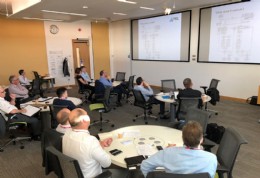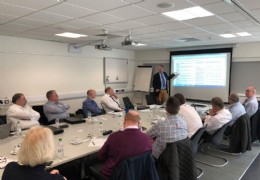Valve Working Group

Chris Williamson, Engineering Director, BEL Valves

Valve WG receive update on API 17TR8 at BP, Sunbury

Martin’s Technical update to Valve WG members at Rotork Leeds in March
Our first meeting of the year was held at Rotork Leeds on March 8th and was hosted by Mathew Knapton, preceded by the now well-established social event on the evening before the session. The only downside to the event was a morning of heavy snowfall that restricted some of the members from attending the Working Group.
The meeting agenda has been enhanced to include a quality moment and a short technical presentation on a topic that is of interest to members. A Technical presentation from Latty on fugitive emissions stem packing was well received. The meeting finished with a very interesting tour of Rotork’s facility.
The second meeting of the year on October 10th was hosted by Steve Jenkins of BP at the BP Upstream Learning Centre in Sunbury. Again, a full house of some twenty members ensured a full day of discussion and debate.
PDL gave a presentation on API 17TR8 which is a technical report that serves as design guidelines for high-pressure high-temperature (HPHT) equipment, specifically for subsea applications which include valves.
An important area for further working group discussion was presented by BP on the work being done by The International Association of Oil & Gas Producers.
IOGP have been progressing standardisation of equipment and packages under the banner of JIP33. Contained within JIP33 is specification S-562 “Supplementary Requirements to API Specification 6D Ball Valves” which has finished its first review and is currently being incorporated in BP and other end user valve specifications.
At both working groups an area of growth and focus has been on the Technical Expert Groups (TEGs).
This year TEGs have been active in the following areas; Fugitive Emissions, SILs, Subsea, Diaphragm valves, UK Qualification Scheme SVs/RVs, API and ISO 8000. A newly rebirthed Fire Test TEG held its first meeting to determine responses to a revision of ISO 10497.
These TEGs are at various stages of maturity and comprise a small number of experts interested in the TEG’s subject matter. The TEGs have proved a good focal point to look at short or long-term industry challenges, developments, new standards and related issues.
Martin Greenhalgh – BVAA’s Technical Consultant – has throughout the meetings provided in-depth updates and commentary for industrial valve standards. Similarly, Ron Strang has done the same with regard to the PED and ATEX directives and some input into the potential effects of Brexit.
API activity has been very prolific with many standards in various stages of revision. Notably the following standards being revised or published; API 6A 21st Edition and API 6FA 4th Edition published and API 6D 25th Edition being revised. Reporting on 6D activity from Houston has been by John Marsh, Goodwin’s, who has attended in person.
Our first meeting of the 2019 year is planned for March 7th at Goodwin International.

| Telephone: | 01295 221270 |
| Email: | enquiry@bvaa.org.uk |
| Website: | www.bvaa.org.uk |
| More information on the British Valve and Actuator Association BVAA Member Directory Page |
Search related valve / actuator articles: British Valve and Actuator AssociationIssue 48BVAA NewsBVAA Annual ReportsNews







-web.jpg)





